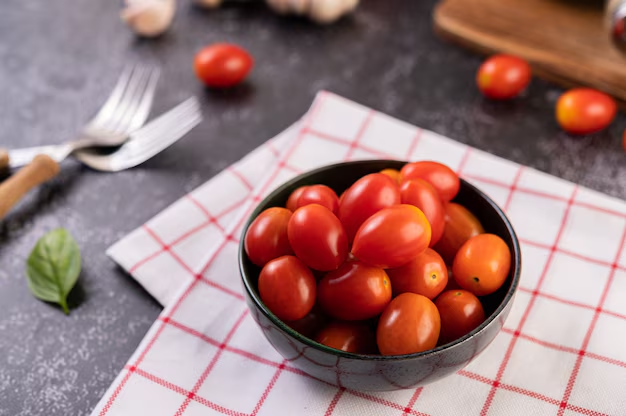Mastering Tomato Storage: A Comprehensive Guide to Refrigeration Success
Storing tomatoes can seem straightforward, but ensuring their freshness and flavor requires knowing a few key tips and tricks. Mastering their storage not only preserves taste but also extends their shelf life. Dive into this guide to master the art of storing tomatoes in the refrigerator.
🍅 Understanding Tomatoes: Nature’s Juicy Delight
What Makes Tomatoes Unique?
Tomatoes stand out as a beloved staple in many kitchens due to their vibrant flavor and nutritional benefits. They're packed with vitamins, antioxidants, and a juicy texture that enhances countless dishes. However, tomatoes are delicate and sensitive to temperature changes, significantly affecting their quality.
The Shelf Life of Tomatoes
- Fresh off the Vine: Ideally, tomatoes are best enjoyed fresh, when they are plump and firm.
- Storage Sensitivity: They can quickly over-ripen if not stored properly, leading to spoilage.
Understanding these aspects is crucial in choosing the right storage method, particularly when opting for refrigeration.
Why Refrigerate Tomatoes?
Pros of Refrigerating Tomatoes
While some believe refrigeration can damage the flavor, there are specific circumstances where it's beneficial:
- Slows Over-Ripening: The cooler temperature reduces the ripening process, making it valuable for ripe tomatoes.
- Prolongs Freshness: For tomatoes nearing their peak ripeness, the refrigerator can be a savior, extending usability by a few more days.
Cons to Consider
- Flavor Loss: Prolonged refrigeration can result in a loss of taste and texture.
- Mealy Texture: The cold environment may alter the tomato's consistency, becoming grainy over time.
Refrigeration should be a strategic choice based on the tomato's ripeness and intended use.
Strategic Refrigeration: Steps for Success
1. Selecting the Right Tomatoes for Refrigeration
- Ripe and Ready: Opt for tomatoes that are fully ripe but not overripe.
- Check the Skin: Look for blemishes, splits, or soft spots that might worsen in the cold.
2. Preparation Techniques
Before placing tomatoes in the refrigerator, a few preparatory steps help maintain their quality:
- Don’t Wash: Wait to rinse until you’re ready to use them, preventing microbial growth.
- Separate and Store: Ensure tomatoes aren't touching, reducing the risk of bruising.
3. Temperature and Placement
Maximize the storage success with these tips:
- Optimal Range: Keep the refrigerator temperature between 45°F and 50°F (7°C and 10°C).
- Proper Placement: Use the vegetable drawer where the temperature is most stable.
4. Use It or Lose It
Plan usage accordingly:
- Consume Promptly: For best results, consume refrigerated tomatoes within three to four days.
- Bring to Room Temperature: Before use, allow them to come to room temperature to revive some flavor and aroma.
🍅 When to Skip Refrigerator Storage
The Importance of Ripeness
- Unripe Tomatoes: Keep these on the counter to naturally ripen.
- Full-Flavor Tomatoes: Store room-temperature for ultimate taste when planning to consume quickly.
Understanding the ripeness helps determine the most suitable storage strategy without compromising flavor.
Alternatives to Refrigeration for Tomato Storage
Room Temperature Storage
Allow tomatoes the chance to develop their natural flavors with room-temperature storage techniques:
- Temperature Control: Keep away from direct sunlight and heat.
- Air Circulation: Place on a single layer with good airflow to prevent bruising.
Preserving Options
For those tomatoes inching toward spoilage, consider other preservation methods:
- Freezing: A great option for future sauces or stews.
- Canning: An age-old favorite, it locks in flavor and nutrients.
🌟 Quick Tips for Tomato Storage Success
Here's a handy bullet-point list for quick reference, complete with emojis for ease:
- 🍅 Ripe and Ready: Only refrigerate ripe tomatoes.
- 🚫 Don't Wash: Only rinse before use.
- 💡 Maintain Temperature: Aim for 45°F - 50°F.
- 🗓️ Act Fast: Consume within three to four days of refrigeration.
- 🔄 Room to Chill: Let return to room temperature prior to use.
- 🌞 Skip Fridge for Unripe: Let them ripen naturally on the countertop.
With these guidelines and tips, you have everything you need to store tomatoes successfully and ensure long-lasting flavor and freshness. By understanding their needs and recognizing their ripeness, you can make the best choice for preserving their delightful taste in various culinary dishes.
